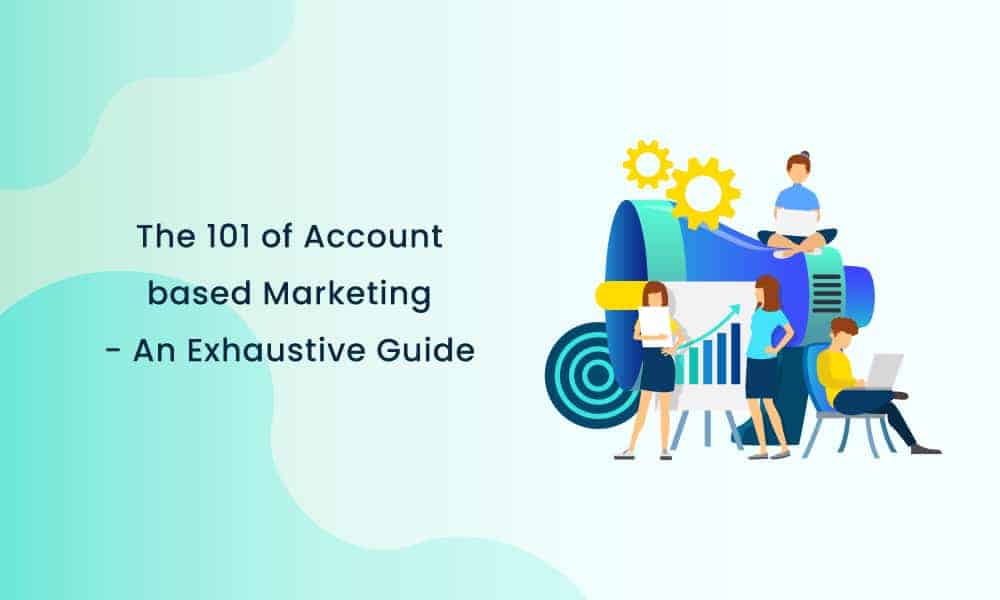Account-based marketing is a new type of strategy that focuses on targeting specific accounts, rather than individuals.
It’s an approach to digital marketing that has been used by the likes of Facebook and Salesforce, but not many marketers are familiar with it.
Account-based marketing is fast growing into a billion-dollar industry, and only getting bigger.
In this blog post, we’ll show you:
- What account-based marketing is
- How account-based marketing works
- The benefits of ABM over traditional marketing
- Types of account-based marketing
- Tips to improve your account-based marketing campaigns
- Six great ABM platforms
Table of Contents
What is Account-Based Marketing?
Account-Based Marketing (ABM) is a strategy that aligns marketing and sales efforts to focus on accounts, rather than leads. Companies using this technique are better able to nurture relationships with key decision-makers throughout the buying cycle by understanding their specific needs and pain points.
The ABM approach uses account-based data and technology to find valuable target accounts, attract and engage them, convert prospects to sales, and measure the success rate.
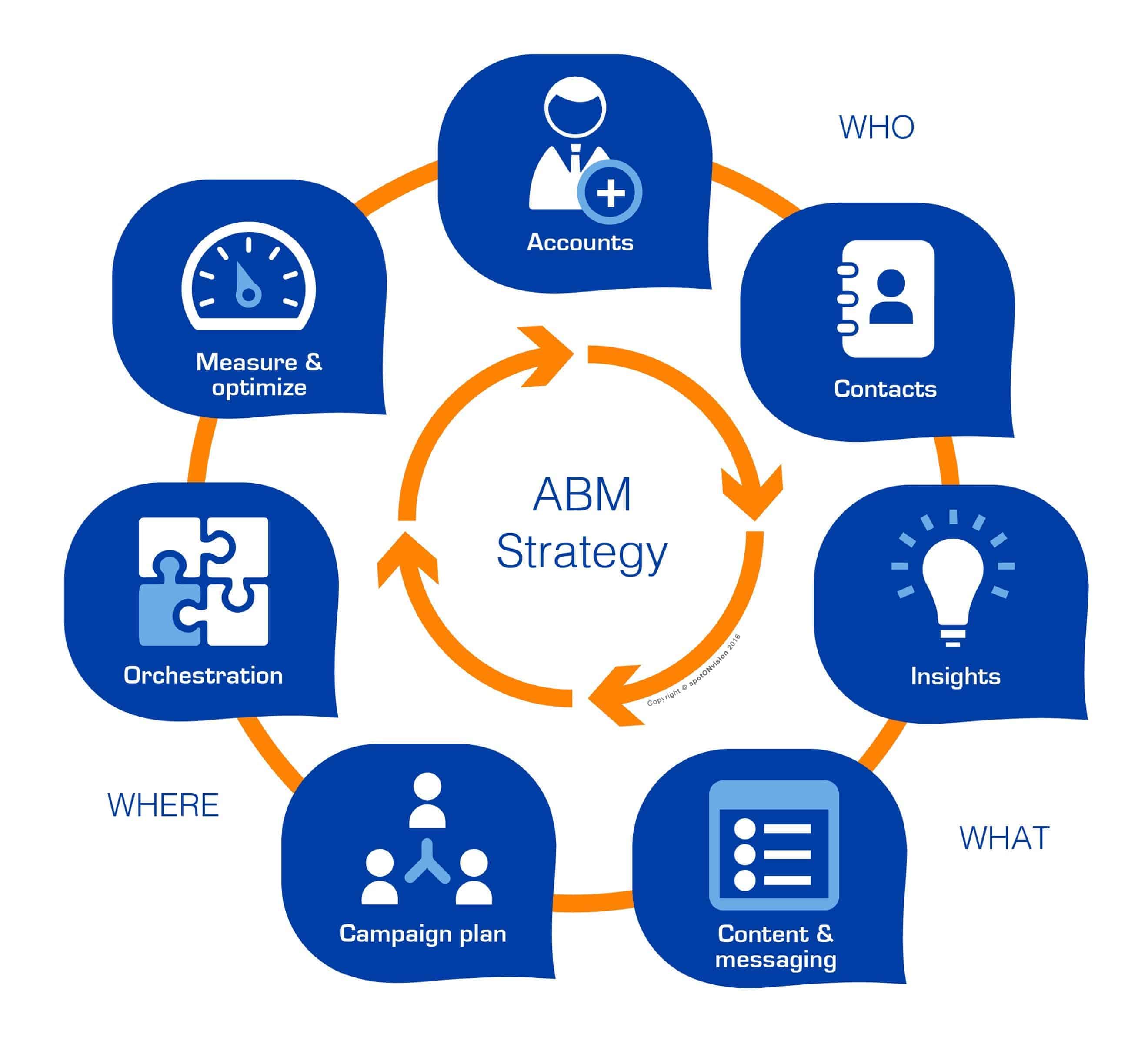
How Does Account-Based Marketing Work?
Let us look at the six simple steps to implement an ABM campaign.
1. Identify Target Accounts
ABM takes a strategic approach to marketing activities to deliver more personalized messages to the right accounts. It doesn’t rely heavily on generalized outbound tactics like email blasts, blogging, or content syndication, which can be inefficient for generating interest at scale.
An account-based strategy is all about identifying key contacts throughout an organization that influence purchase decisions (decision-makers, influencers, end-users). Think about the BANT framework when identifying key contacts.
Once you have identified your target accounts, create an account-based campaign to engage with your contacts across the buying cycle.
Use this opportunity to get in front of decision-makers at scale with personalized messages that speak to the specific needs of your target accounts.
Remember, it’s not about you; it’s about your most important prospects and customers, and what they need!
Here’s a great video that explains the basics of account-based marketing:
2. Research the Accounts
Once you have a list of your key target accounts, do extensive research on each account.
Unless you are aware of what the decision-makers want, you will not be able to cater to their needs and fulfill their requirements.
Information and knowledge are the key aspects of account-based marketing. It is vital to know intricate details about every target account.
Account-based marketing is not new. Only, it has re-emerged now as technology has pushed the boundaries of what’s possible.
These technologies can help you research accounts on a much deeper level and understand your customers better.
Read also: 11 Small Business Marketing Tips for a Boost in Conversions
3. Create Appropriate Content
A powerful account-based marketing campaign is one where you employ accurate, crisp, and personalized content that caters to the specific account.
Needless to say, the campaign addresses every pain point and challenge faced by the customer, or ‘account’.
4. Determine the Channels
The next step is to determine how to reach the prospects and which channels to use so that the right message reaches them at the right time.
Leverage omnichannel marketing and make the most of web, email, phone, and SMS marketing.
More importantly, you need to define the optimal channel for every target account.

5. Align Your Marketing and Sales Efforts
The efforts of both the marketing and sales team should be aligned across channels for maximized deliverability.
This is where technology comes to play.
Technology has made it possible for businesses to implement and manage account-based marketing initiatives more efficiently, at scale.
Read also: Relationship Marketing Definition and 10 Proven Strategies for Customer Happiness
6. Measure Your Results, Optimize Your Campaigns
No matter how perfectly you plan your campaigns, there’s a chance something does not work as expected.
That’s why you must periodically test and optimize your account-based marketing campaigns. This ensures that your campaigns become more effective in the long run.
You also need to assess individual campaigns, results from each account, and compare them.
This way, you get a holistic view of how your company is performing.
Why ABM is Better than Traditional Marketing
Let us see how account-based marketing is better than traditional B2B marketing.
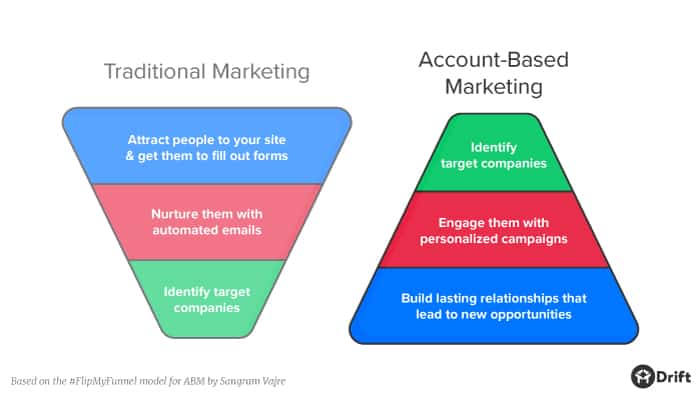
Some of the major benefits of ABM are as follows:
Personalized Communication
The ABM approach helps marketers create and focus content based on the target account. This way, marketers can craft new marketing activities that appeal to the decision-makers at every key B2B prospect.
ABM will enable marketers to reach customers better with targeted content to increase interactions and sales.
Better ROI
About 84% of marketers who have used account-based marketing campaigns feel that it has a higher return on investment than other marketing techniques.
Also, it is much easier to measure the ROI in account-based marketing, thanks to the focused approach.
Read also: 17 Powerful Techniques to Generate B2B Sales Leads
Efficient Use of Marketing Resources
A streamlined and focused approach for different target accounts helps your organization channel its resources the right way.
ABM enables the optimum use of time, money, and workforce to achieve the best marketing results.
Closer Alignment Between Sales and Marketing
ABM requires a close alignment between the sales and marketing teams.
According to a survey, marketers who use ABM are about 40% more likely to report alignment with their sales team compared to others.
This kind of collaboration helps in the overall growth and prosperity of the organization, in addition to the higher marketing ROI.
According to statistics, more than 70% of B2B firms now depend on account-based marketing as their primary marketing method.
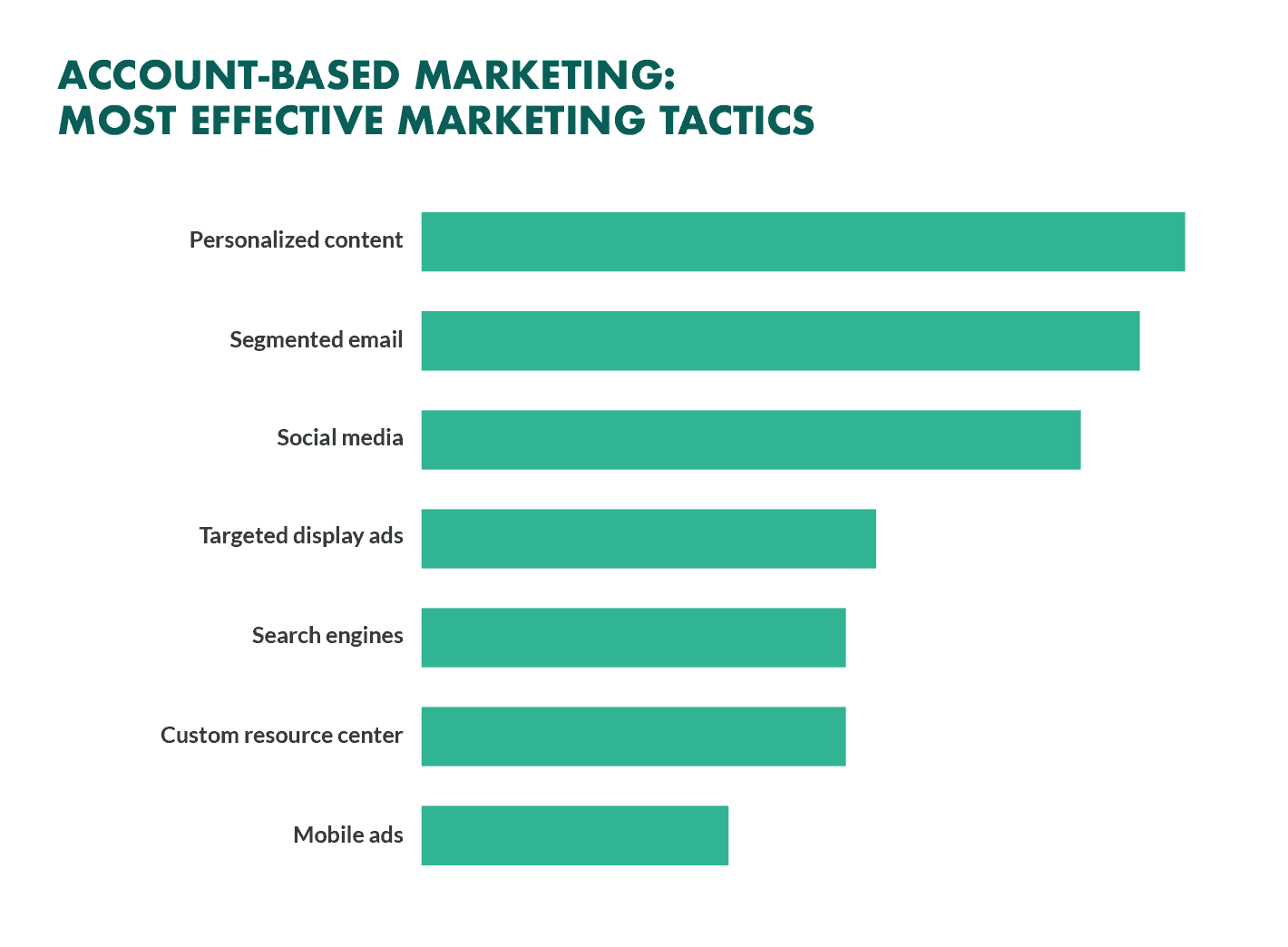
Read also: Beyond Basic Branding: How Integrated Marketing Helps
The Different Types of Account-Based Marketing
ABM can be classified into four major types.
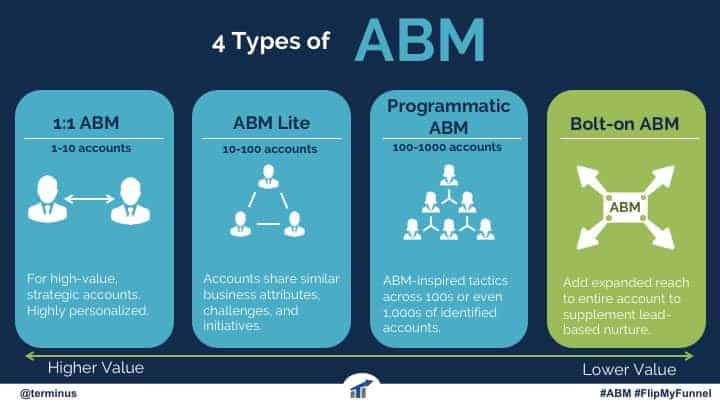
1. ABM Lite
This is a one-to-many model. It can range from 10 to 100 target accounts. Usually, a small group of accounts with similar business attributes or challenges are targeted.
Then, marketers collaborate with the sales team on which accounts to target, issues to highlight, what propositions will work best, and how the existing content can be tailored for the target accounts.
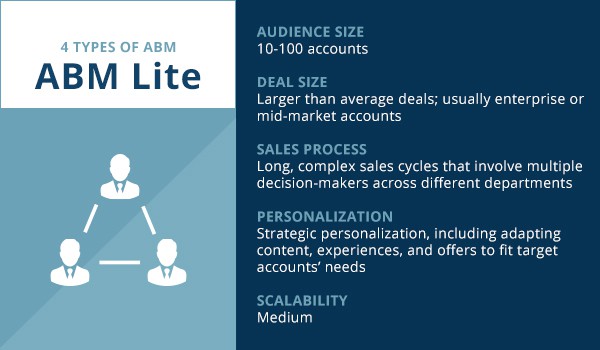
2. Programmatic ABM
This is a one-to-many approach that focuses on generating, nurturing, and tracking leads from an account-based view.
With technology enabling analytics and personalization across many target accounts, one marketer can work on several accounts.
This makes marketing less resource-intensive.
The coverage is also more than Strategic ABM or ABM Lite.
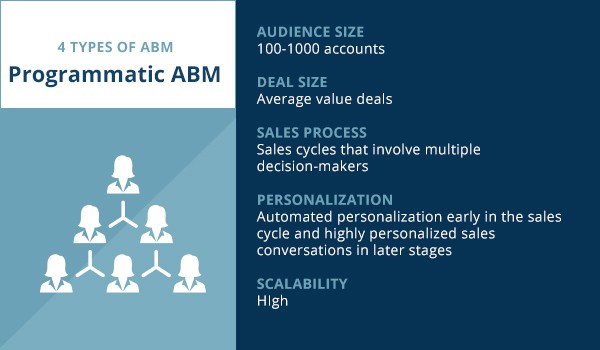
Read also: Account-Based Marketing vs Marketing Automation: A Guide
3. Bolt-on ABM
Bolt-On ABM allows marketers to interact with the rest of the buying committee while still marketing to one specific lead. When a lead comes in and gets qualified, it gets routed and placed in a nurture campaign.
A Bolt-On ABM strategy uses technology to trigger actions to engage other persons from that particular company when a lead progresses through the funnel.
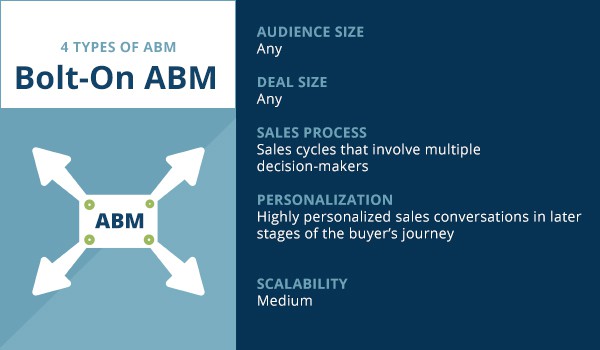
4. Strategic ABM
Strategic ABM is highly specialized and tailored for each individual.
This is mainly for 1:1 accounts.
In this approach, a dedicated, senior-level marketer interacts directly with one or a very few strategic and key account teams on the sales side and helps customize marketing plans for each account.
Strategic ABM is used for large and enterprise-level deals but has low scalability because of the 1:1 approach.
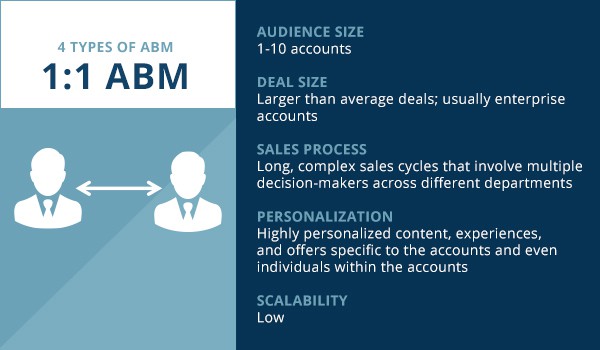
6 Proven Account-Based Marketing Tips
It’s time you put your ABM knowledge to work.
Here are six tried and tested tips to make the most out of your ABM campaigns.
1. Engage With Educational Content
Educational content like blogs, informative guides, business videos, infographics, and others play an important role in engaging customers.
The audience gets information on related topics — and you can position yourself as a subject-matter expert.
2. Send Personalized Emails
Personalized emails can be the easiest and most compelling aspect of account-based marketing — if done in the right way.
Segmentation, smart lists, welcome emails, and personalized autoresponders can help nail that personal touch.
You can go one step further by using analytics to understand your accounts’ interests and pain points and then target them using relevant content.
Read also: 20 Actionable Email Marketing Tips That Drive Results
3. Use Social Media to Target the Right Audience
Social media targeting is another excellent marketing strategy and can be the best place to collect information about target buyers and deliver the right content.
The way people engage on social media can give marketers the right clues on what they are looking for and how they can cater to customer needs.
4. Work With Partners to Engage Customers
It is very important to know the decision-makers of an account to make the most of the transactions.
Know about the stakeholders and the buying parties of a target account and work together to close deals.
This is an excellent account-based marketing strategy for B2B marketers because it helps them formulate the ideal customer profile.
5. Implement a Direct Mail Campaign
Sometimes, an account-based, direct mail campaign might work as an integral part of ABM.
A direct email with a small value proposition works better for targeting a valued customer.
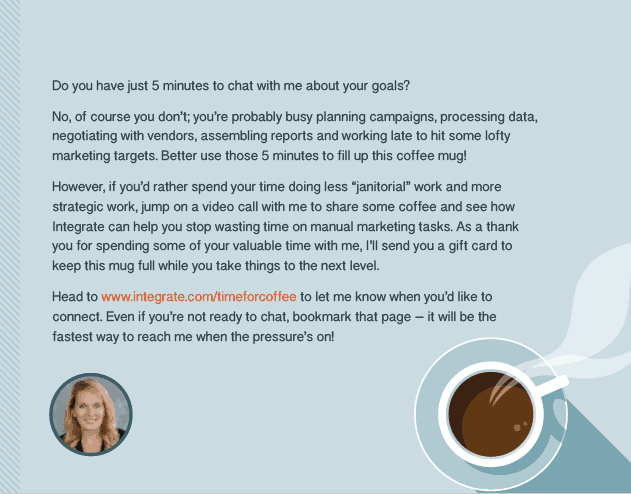
6. Host Events for Target Accounts
Engaging with valued customers through a physical event might be a good idea.
It can be a big networking event or smaller city-based meetings to connect face-to-face with key customers and decision-makers.
Read also: Inbound Marketing Guide — Definition, Stages, and Marketing Strategy
The Best ABM Software for Small Businesses
Now, let us look at some of the best account-based marketing software in the market that can boost your performance and productivity.
EngageBay: EngageBay is an all-in-one marketing, sales, and customer support software that offers end-to-end ABM solutions at affordable rates with free onboarding sessions. You get a host of powerful features, including inbound marketing, marketing automation, prospect management, personalized campaigns, customer engagement tools, and of course, account-based marketing.
Adobe Campaign: Adobe Campaign has always been in the market as a reliable tool. Now, they have added a lot of new tools such as campaign creations for mobile or desktop marketing projects, email campaigns, and overall goal fulfillment.
6Sense: The systems are powered with patent-protected predictions, which helps determine who is in an active buying cycle, when they will buy and where they are in the buyer’s journey.
Terminus: Their ABM tools include central Hub, a digital marketing platform with personalized targeting on accounts, and engagement insights.
Bound: They can create personalized paths for visitors to take when they come to your homepage, making them more likely to navigate it. This helps drive on-site traffic and lead generation.
Read also: 13 Best Email Marketing Software to Grow Your Business
Conclusion
An ABM strategy will increase revenue and change the way you do business.
When sales and marketing teams work together to enhance a buyer’s journey, the result will surely be greater ROI and happy customers.
ABM is a necessity in today’s dynamic and competitive business scenario, especially when it is B2B sales you need to win at.
If you are a small business with a limited budget and you want to incorporate ABM into your marketing strategy, EngageBay is the best choice.
For just $79.99 a month, you get a host of powerful professional-grade tools, including account-based marketing, unlimited contacts, and inbound marketing.
Book a demo with us or sign up now for free — no credit card required!
